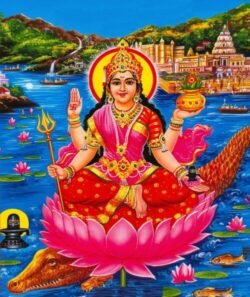Table of Contents
- Introduction
- 1. Tribal Communities and Traditional Wisdom
- 2. Villagers as Custodians of Rituals
- 3. Devotees and the Parikrama Tradition
- 4. Eco-Projects and Modern Initiatives
- 5. The Spiritual Ecology of Narmada
- Conclusion
Introduction
The Narmada is more than a river—it is a lifeline, a mother, and a sacred presence for countless communities along her banks. For centuries, local tribes, villagers, and devotees have served as her guardians, preserving both her sanctity and ecology. Their traditions, rituals, and collective efforts reflect a deep bond with the river, ensuring that she continues to flow as a source of life and spirituality.
1. Tribal Communities and Traditional Wisdom
- Indigenous groups such as the Bhil, Gond, and Baiga tribes live in harmony with the river and forests.
- Their traditions include strict taboos against polluting the waters.
- Sacred groves along the Narmada are protected by these tribes as spiritual sites where trees and plants cannot be cut.
- Knowledge of medicinal plants and sustainable fishing practices has been passed down through generations.
2. Villagers as Custodians of Rituals
- Villagers along the Narmada observe rituals that honor the river as Narmada Mata.
- Daily offerings of flowers, diyas, and prayers express gratitude while reinforcing respect for her purity.
- Certain communities prohibit washing clothes or disposing of waste in the river, preserving its sanctity.
- During festivals like Narmada Jayanti, entire villages unite in celebrations that reaffirm their bond with the river.
3. Devotees and the Parikrama Tradition
- Pilgrims performing the Narmada Parikrama are bound by vows of non-violence, simplicity, and respect for the river.
- They live in tune with nature, avoiding actions that could harm the water or surrounding forests.
- This centuries-old practice spreads awareness about the sacredness of the Narmada far beyond her valley.
4. Eco-Projects and Modern Initiatives
- Local NGOs and community-led projects work to plant trees along eroded riverbanks.
- Youth groups in towns like Omkareshwar and Hoshangabad organize river-cleaning drives.
- Some ashrams encourage eco-awareness by teaching pilgrims about conservation alongside spiritual practices.
- Partnerships between traditional knowledge and modern environmental science are helping safeguard biodiversity.
5. The Spiritual Ecology of Narmada
- For the communities, the river is not just a resource but a goddess to be worshipped and protected.
- This spiritual ecology creates a moral framework where harming the river is seen as a sin.
- Stories, songs, and folklore passed down generations remind people of their duty to serve as her protectors.
Conclusion
The Narmada survives as a sacred and living river not only because of her natural strength but also because of the guardianship of those who live along her banks. From tribal wisdom to pilgrim vows and modern eco-projects, the communities of the Narmada Valley embody the spirit of stewardship. They remind us that the river is not just water—it is life, heritage, and divinity flowing endlessly through time.
